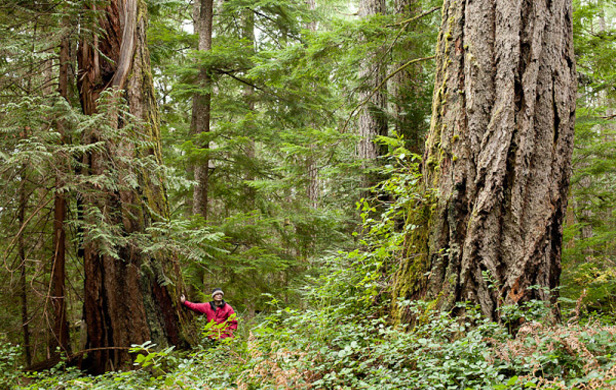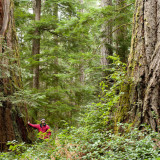
In a world of global business connections, faraway is as close as next door. In this case, next door is Cortes Island, a remnant of rural paradise at the northern edge of the Salish Sea — a pocket of ocean in the Pacific Northwest that a mere century ago teemed with an estimated 500 resident whales and unimaginable quantities of fish and wildlife. Little remains of that original marine bounty. And the surrounding majestic forests of Douglas fir, technically designated as CDFmm (Coastal Douglas-fir,Moist Maritime), have been obliterated to less than 1% of their original area. Cortes Island happens to contain one of the last sparse pockets of this once spectacular forest ecology.
But the business connections that link Cortes Island to the rest of the world are healthy and flourishing. They stretch along the edge of the Salish Sea and beyond. The offices of Island Timberlands (IT), which owns the patch of Douglas fir forest on Cortes Island, are situated in Nanaimo. The headquarters of the BC Investment Management Corporation (bcIMC), which have financial interests in IT, are located in Victoria. Wall Street in New York is the home of Brookfield Asset Management Incorporated, the majority shareholder in Island Timberlands. And Beijing may soon be connected to Cortes Island as the China Investment Corporation (CIC) attempts to use a $100 million sliver of its $200 billion capital to buy a 12.5% stake in Island Timberlands, a purchase that would give it influence over the Vancouver and Cortes Island forests that are now owned by Brookfield.
These are the business forces allied against Cortes and the people of Wildstands Alliance who are trying to mitigate the impact of logging in one of their island’s rare and cherished forests — a forest now “owned” and “managed” by a network of business connections so far removed from the ecological reality of trees and the local community that loves them, that the investors might as well come from another planet.
The proportions must be dismaying to the 1,000 rural folks who live on Cortes. Brookfield is one of the largest investment corporations in the world. It owns 51% of Island Timberlands. bcIMC, which owns a 25% share in IT, manages $92.1 billion in pension funds. Island Timberlands, the corporation that intends to log the remnant coastal Douglas fir forest that Cortes Islanders want to protect, is committed to return profits to bcIMC and Brookfield. The corporate expectations are about lucrative returns on investments, not about trees, ecologies or aesthetics. The logging project, if not stopped or moderated, will contribute to the healthy returns paid to investors by bcIMC and Brookfield. And, in a sad irony, most or all of the logs will likely go offshore for milling and processing.
The next chapter in the dismaying saga of the big-and-international vs. the little-and-local is the intention of the Chinese Investment Corporation to buy a portion of Island Timberlands. Under the terms of the federal government’s pending Foreign Investment Promotion and Protection Agreement, known as FIPA, the fate of this rare stand of Douglas fir on Cortes and 258,000 hectares of forest on Vancouver Island could be decided in secret by a three-person panel appointed by FIPA, if the CIC believes its investment is being unfairly handicapped by federal, provincial or local regulations. This is not an auspicious prospect for Canadians, British Columbians or the stalwart conservation efforts of the Cortes Islanders trying to mitigate the damaging effects of logging on a little remnant of coastal Douglas fir forest.
Their heroic efforts are not supported by the supposedly stringent logging principles of the Sustainable Forestry Initiative (SFI), the guide Island Timberlands uses for its cutting practices. The purported high standards of SFI have been widely debunked by environmental critics as hollow, nothing more than an “initiative” devised and funded by the lumber and paper industry to give the impression of careful ecological management. If credible standards were being used, such as representative ecosystems in protected provincial reserves or the more stringent standards of the Forest Stewardship Council, logging would not be taking place in a maritime forest ecology that has been “managed” to the verge of extinction.
Anyone with a history in environmentalism should be cautious when foresters profess to be “managing” a forest — forests have been successfully managing themselves for millions of years. And when Island Timberlands uses expressions such as “managing our properties”, the coded meaning is even more ominous. It has financial obligations to its New York owners, Brookfield, and to its Victoria investors, bcIMC. These obligations translate as “profit” and have little to do with the sensibilities of Cortes Islanders or the last of the remnant Douglas fir forests ecologies surrounding the Salish Sea.
So the local logging problem on Cortes Island represents a larger problem. Corporations are getting bigger, more borderless and less personal. Trade agreements and investment connections are eroding national, provincial and community autonomy. Although Island Timberlands has 258,000 hectares of Vancouver Island to log, it insists on taking every ounce of the flesh it purports to own, regardless of how treasured and rare it may be.
In the larger perspective, this can only be viewed as an uncaring obstinacy, a blind greed that violates the very principle of proportion which keeps the ecological structure of the planet intact. Locally, it mocks the caring intentions of Cortes Islanders. If the business of business is only reducible to the cold, heartless and inflexible brutality of profit, then little Cortes Island becomes a symbol for the failed prospects of our future on this small and delicate island lost amid a sea of stars.

